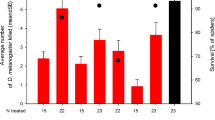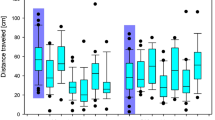Abstract
Factors inducing outbreaks of spider mites (Acari: Tetranychidae) following use of pyrethroid insecticides are reviewed. Differentials in direct toxicity between spider mites and phytoseiid (Acari: Phytoseiidae) predators provide one explanation. Wide variation exists between pyrethroids in their direct toxicity toTetranychus urticae. The acaricidal action of pyrethroids is largely controlled by the amount of irritancy or repellency induced by the respective chemicals. Laboratory assays for repellency reflect field results. Repellent activity induces spider-mite dispersal to either recolonise plants free of residues or leave the treated habitat. Pyrethroids may also affect reproduction and development rates. Residual activity is likely to vary, so limiting any general theory of spider-mite responses to pyrethroids. Variable responses to pyrethroids, strain variation and development of behavioural resistance also add complications to understanding outbreaks. Future research needs are identified.
Similar content being viewed by others
References
Anonymous, 1968. First conference on test methods for resistance in insects of agricultural importance: method for boll weevil and tentative method for spider mites. Bull. Entomol. Soc. Am., 14: 31–35.
Anonymous, 1980–1986. Insecticide and Acaricide Tests, Vols. 5–11. Entomological Society of America, College Park, MD.
Chapman, R.B. and Penman, D.R., 1979a. Negatively correlated cross resistance to a synthetic pyrethroid in organophosphorus resistantTetranychus urticae. Nature (Lond.), 281: 298–299.
Chapman, R.B. and Penman, D.R., 1979b. Toxicity of synthetic pyrethroid insecticides to phytophagous orchard mites. Proc. N.Z. Weed Pest Control Conf., 32: 240–244.
Croft, B.A. and Hoyt, S.C., 1978. Considerations for the use of pyrethroid insecticides for deciduous fruit pest control in the U.S.A. Environ. Entomol., 7: 627–630.
Elliot, M., James, N.F. and Potter, C., 1978. The future of pyrethroids in insect control. Annu. Rev. Entomol., 23: 443–469.
Gerson, U. and Cohen, E., 1988. Resurgences of spider mites (Acari: Tetranychidae) induced by synthetic pyrethroids. Exp. Appl. Acarol., 5: (in press).
Hall, F., 1979. Effects of synthetic pyrethroids on major insect and mite pests of apple. J. Econ. Entomol., 72: 441–446.
Hoy, M.A., 1985. Recent advances in genetics and genetic improvement of the Phytoseiidae. Annu. Rev. Entomol., 30: 345–370.
Hoyt, S.C., 1969. Integrated chemical control of insects and biological control of mites on apple in Washington. J. Econ. Entomol., 62: 74–86.
Hoyt, S.C., Westigard, P.H. and Burts, E.C., 1978. Effects of two synthetic pyrethroid insecticides on the codling moth, pear psylla and various mite species in northwest apple and pear orchards. J. Econ. Entomol., 71: 431–434.
Huffaker, C.B., van de Vrie, M. and McMurtry, J.A., 1970. Ecology of Tetranychid mites and their natural enemies: A review. II. Tetranychid populations and their possible control by predators: An evaluation. Hilgardia, 40: 391–458.
Iftner, D.C. and Hall, F.R., 1983a. Toxicities of selected pyrethroids to two species of phytophagous mites. J. Econ. Entomol., 76: 687–689.
Iftner, D.C. and Hall, F.R., 1983b. Effects of fenvalerate and permethrin onTetranychus urticae Koch (Acari: Tetranychidae) dispersal behaviour. Environ. Entomol., 12: 1782–1786.
Iftner, D.C. and Hall, F.R., 1984. The effects of fenvalerate and permethrin residues onTetranychus urticae Koch fecundity and rate of development. J. Agric. Entomol., 1: 191–200.
Jones, V.P. and Parrella, M.P., 1984. The sublethal effects of selected insecticides on life table parameters ofPanonychus citri (Acari: Tetranychidae). Can. Entomol., 116: 1033–1040.
Marwick, N.P., 1986. Detecting variability and selecting for resistance in two species of phytoseiid mites. Entomophaga, 31: 225–236.
McKee, M.J. and Knowles, C.O., 1984. Effects of pyrethroids on respiration on the two-spotted spider mite (Acari: Tetranychidae). J. Econ. Entomol., 77: 1376–1380.
McKee, M.J. and Ibrahim, Y.B. and Knowles, C.O., 1987. Relationship between dispersal and fecundity ofTetranychus urticae Koch (Acari: Tetranychidae) exposed to flucythrinate. Exp. Appl. Acarol., 3: 1–10.
McMurtry, J.A., Huffaker, C.B. and van de Vrie, M., 1970. Ecology of tetranychid mites and their natural enemies: A review I. Tetranychid enemies: their biological characters and the impact of spray practices. Hilgardia, 40: 331–370.
Penman, D.R. and Chapman, R.B., 1983. Fenvalerate-induced distributional imbalances of two-spotted spider mite on bean plants. Entomol. Exp. Appl., 33: 71–78.
Penman, D.R., Chapman, R.B. and Jesson, K.E., 1981. Effects of fenvalerate and azinphosmethyl on two-spotted spider mite and phytoseiid mites. Entomol. Exp. Apl., 30: 91–97.
Penman, D.R., Chapman, R.B. and Bowie, M.H., 1986. Direct toxicity and repellent activity of pyrethroids againstTetranychus urticae (Acari: Tetranychidae). J. Econ. Entomol., 79: 1183–1187.
Penman, D.R., Chapman, R.B., and Bowie, M.H., 1987. Development of behavioral resistance inTetranychus urticae Koch (Acari: Tetranychidae) to flucythrinate. J. Econ. Entomol., 81: 40–44.
Plaut, H.N. and Cohen, M., 1978. Trials on the control ofLithocolletis blancardella F. (Lep.: Gracillaridae) on apple trees with difubenzuron and permethrin. Alon Hanotea, 33: 5–11.
Riedl, H. and Hoying, S.A., 1983. Toxicity and residual activity of fenvalerate toTyphlodromus occidentalis (Acari: Phytoseiidae) and its preyTetranychus urticae (Acari: Tetranychidae) on pear. Can. Entomol., 115: 807–813.
Rock, G.C., 1979. Relative toxicity of two synthetic pyrethroids to a predatorAmblyseius fallacis and its preyTetranychus urticae. J. Econ. Entomol., 72: 293–294.
Roush, R.T. and Hoy, M.A., 1978. Relative toxicity of permethrin to a predator,Metaseiulus occidentalis, and its prey,Tetranychus urticae. Environ. Entomol., 7: 287–288.
Suckling, D.M., Chapman, R.B. and Penman, D.R., 1984. Insecticide resistance in the lightbrown apple moth (Epiphyas postvittana Walker): larval responses to azinphosmethyl. J. Econ. Entomol., 77: 579–583.
Wong, S.W. and Chapman, R.B., 1979. Toxicity of synthetic pyrethroid insecticides to predacious phytoseiid mites and their prey. Aust. J. Agric. Res., 30: 497–501.
Zwick, R.W. and Fields, G.J., 1978. Field and laboratory evaluations of fenvalerate against several insect and mite pests of apple and pear in Oregon. J. Econ. Entomol., 71: 793–796.
Author information
Authors and Affiliations
Rights and permissions
About this article
Cite this article
Penman, D.R., Chapman, R.B. Pesticide-induced mite outbreaks: pyrethroids and spider mites. Exp Appl Acarol 4, 265–276 (1988). https://doi.org/10.1007/BF01196190
Accepted:
Issue Date:
DOI: https://doi.org/10.1007/BF01196190




